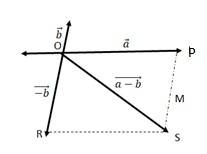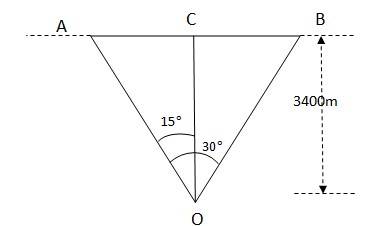Motion in a Plane
Get insights from 112 questions on Motion in a Plane, answered by students, alumni, and experts. You may also ask and answer any question you like about Motion in a Plane
Follow Ask QuestionQuestions
Discussions
Active Users
Followers
New answer posted
6 months agoContributor-Level 10
4.29 The angle of projectile = 30
The bullet hits the ground at a distance of 3 km, Range R = 3 km
We know horizontal range for a projectile motion, R = sin2 / g
3 = sin60 / g
= 3/ sin60 = 3.464 …………… (1)
To hit a target at 5 km,
Max Range, = …………. (2)
On comparing equation (1) and (2), we get
= 3.464
Hence, the bullet will not hit the target even by adjusting its angle of projection.
New answer posted
6 months agoContributor-Level 10
4.28
(a) We cannot associate the length of a wire bent into a loop with a vector.
(b) We can associate a plane area with a vector.
(c) We cannot associate the volume of a sphere with a vector.
New answer posted
6 months agoContributor-Level 10
4.27 No in the both the cases.
A physical quantity which is having both direction and magnitude is not necessarily a vector. For instance, in spite of having direction and magnitude, current is a scalar quantity. The basic necessity for a physical quantity to fall in a vector category is that it ought to follow the “law of vector addition”.
As the rotation of a body about an axis does not follow the basic necessity to be a vector i.e. it does not follow the “law of vector addition”.
New answer posted
6 months agoContributor-Level 10
4.26 Yes and No
A vector in space has no distinct location. The reason behind this is that a vector stays unchanged when it displaces in a way that its direction and magnitude do not change.
A vector changes with time. For instance, the velocity vector of a ball moving with a specific speed fluctuates with time.
Two equivalent vectors situated at different locations in space do not generate the same physical effect. For instance, two equivalent forces acting at different points on a body to rotate the body, but the combination will not generate the equivalent turning effect.
New answer posted
6 months agoContributor-Level 10
velocity of a freely falling body is v=
And
-1
The wavelength of a photon needed to remove a proton from a nucleus which is bound to the nucleus with 1 MeV energy is nearly
a) 1.2 nm (b) 1.2 x 10-3 nm
(c) 1.2 x 10-6 nm (d). 1.2 x 10 nm
New answer posted
6 months agoContributor-Level 10
(d)

We can write
OS + PS > OP …….(i)
OS > PS – OP …….(ii)
+ ….(iii)
The quantity on the LHS is always positive and that on the RHS can be positive or negative. To make both quantities positive, we take modulus of both sides as:
> ….(iv)
If the two vectors and act along a straight line but in the opposite direction, then we can write = -
Combining (iv) and (v), we get
-
New answer posted
6 months agoContributor-Level 10
Ans.4.21: (a) Velocity , = 10.0 ? m/s Acceleration, = (8.0 ? + 2.0 ?) m s-2 We know = = 8.0 ? + 2.0 ? = (8.0 ? + 2.0 ?)dt Integrating both sides we get (t) = 8.0t ? + 2.0t ? + , Where, velocity vector of the particle at t =0 velocity vector of the particle at time t But = = dt = (8.0t ? + 2.0t ? + )dt Integrating both sides with the condition at t = 0, r =0 and at t =t, r = r t + ½ 8.0 t2 ? + ½ 2.0 t2 ? = t + 4.0 t2 ? + t2 ? Substituting the value of , we get ( 10.0 ?)t + 4.0 t2 ? + t2 ? . This equation can be expressed as x ? + y ? = 4.0 t2 ? + ( 10.0t + t2) ? Since the motion of the particle is confined to the x-y plane, on equating the coefficients of ? and ?, we get x = 4.0 t2 and y = 10.0t + t2 t = (a) When x = 16m, t = 2 s, y = 24m (b) Velocity of the particle (t) = 8.0t ? + 2.0t ? + At t = 2 s, (t) = 8.0 2 ? + 2.0 ? + 10 ? = 16 ? + 14 ? The magnitude of (t) is given by = ( 162 + 142)1/2 = 21.26 m/s |
New answer posted
6 months agoContributor-Level 10
4.25

Height of the aircraft from the ground = 3400m
Let A and B be the positions of the aircraft, making an angle of AOB = 30 . The perpendicular OC and OC is the height of the aircraft. Angles AOC = angle BOC = 15
In AOC, AC = OC
= 3400 = 911.03m
AB = AC + CB = 2AC = 1822m
The distance of AB is covered in 10s, so the speed of the aircraft = 1822/10 m/s = 182.2 m/s
New answer posted
6 months agoContributor-Level 10
4.24
(a) Despite being a scalar quantity, energy is not conserved in elastic collisions. False
(b) Despite being a scalar quantity, the temperature can take negative values. False
(c) The total path length is a scalar quantity. Yet it has the dimension of length. False
(d) A scalar quantity such as gravitational potential can vary from one point to another point in space. False
(e) The value of a scalar does not vary for observers with different orientation of axis. True
New answer posted
6 months agoContributor-Level 10
4.23
(a) For any arbitrary motion of a particle average velocity cannot be expressed by this equation. False
(b) The arbitrary motion of the particle can be represented by this equation, True
(c) For arbitrary motion of the particle, the acceleration may also be non uniform. False
(d) The motion of the particle is arbitrary, acceleration of the particle may also be non-uniform, so can not represent the motion of the particle in space. False
(e) The arbitrary motion of the particle can be represented by the given equation. True
Taking an Exam? Selecting a College?
Get authentic answers from experts, students and alumni that you won't find anywhere else
Sign Up on ShikshaOn Shiksha, get access to
- 65k Colleges
- 1.2k Exams
- 679k Reviews
- 1800k Answers
